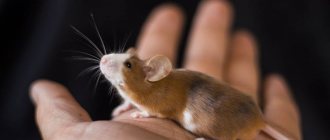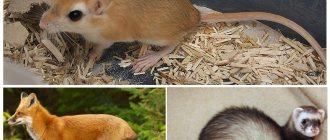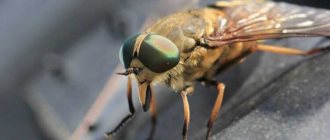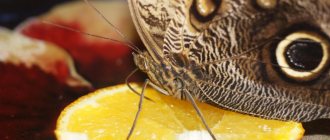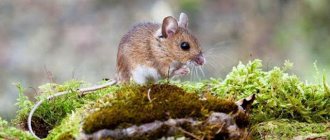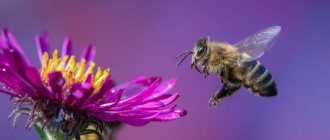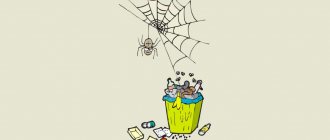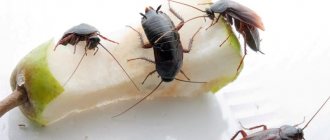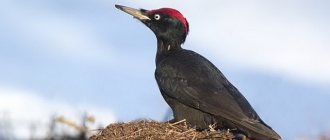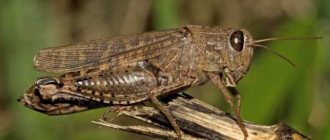The diet of buzzing insects is quite varied. They can eat pollen, nectar, beebread and their own honey. The main food supply for insects from spring to autumn is honey plants.
Bees collect pollen and nectar:
- from acacia, linden, buckwheat, alder and hazel;
- from apple, pear, cherry, bird cherry and other flowering trees and shrubs;
- from sunflower, dandelions, clover, lupine, rapeseed.
Many crops are planted specifically next to the apiary, taking into account the flowering time.
The main factor for a bee to choose a flower is scent. Plants use special glands to emit a pleasant smell to attract honey plants. Therefore, choose lilies of the valley, daffodils, jasmine and other fragrant plants.
Honey plants are the name given to flowering plants from which bees collect pollen or nectar. How the insects themselves figure this out is unknown to science. From linden and buckwheat, for example, bees collect only nectar, and from corn, poppy, and alder - pollen. But some types of plants have a universal purpose: insects collect both from them. Examples are red clover, field dandelion, and sunflower.
What do wild bees eat?
To properly organize the care of healthy honey plants in the apiary, you need to study their natural nutrition. Then it will be possible to provide similar conditions on your site. Let's look at what bees eat in nature, in their natural environment.
Honey plants in the wild collect nectar from flowering plants, which they carry in their crops. There it partly becomes honey. The produced enzyme invertase divides everything extracted into fruit and cane sugar. Although the transformation does not end with this product. On the way to the hive, the bee spends 20-40% of what it collects on its own food, restoring its strength.
This expense is the main thing that bees eat. Upon arrival at the hive, the insect deposits a partially processed drop of nectar into the honeycomb cell. Just leaves it on the top. The collected nectar continues to be exposed to the enzyme in the honeycomb. When 20% water remains in the product, it can be considered honey - a supply of food.
The diet of honey plants consists not only of nectar and honey. Worker bees also drink water, eat beebread, and many types of pollen. The latter, while on the flower, sticks to the hairs of their body right up to the eyes. The insect moistens the collected pollen with saliva and, upon flying home, deposits it in a specific honeycomb cell. Fermentation occurs there, resulting in the formation of a protein product - bee bread.
Speaking about what bees love, we should mention their main food supply, consisting of honey plants:
- linden, acacia, alder - flowering trees and shrubs;
- buckwheat;
- pears, apple trees, bird cherry trees are fruit-bearing trees;
- clover, dandelions, rapeseed, sunflowers - wild and garden flowers.
Having become familiar with the timing of flowering and nectar collection using the example of wild bees, people began to plant the corresponding plants near the apiary.
How to preserve honey
When talking about what a bee eats, one cannot fail to mention ways to reduce honey crystallization:
- Be sure to have plenty of water in the hive.
- Before winter, you should clean the hive of last year's treats. If there are still sugar crystals left from the previous year's harvest, you need to get rid of them immediately.
- It is important to maintain a constant temperature. The crystallization process of honey slows down if the temperature drops below thirteen degrees or rises above fourteen.
What do bees eat in the apiary?
As soon as the honey in the hive reaches the desired humidity threshold (20% water), the honeycombs are sealed by the bees, who secrete a thin layer of wax from the body for this purpose. The content continues to reach the required condition. The product collected in summer is intended for winter nutrition of the bee colony.
In search of honey plants, insects travel long distances. Bees eat honey for this purpose to replenish their strength, and for several days at once. After all, when they are hungry, they die during the flight.
The development of insects is ensured by protein food, which also allows them to successfully reproduce in the spring. It contains:
- beebread;
- pollen;
- autumn and winter feeding provided by insects and humans.
The latter remedy is used when food supplies are insufficient. Protein is replenished with easily digestible cow's milk. Beebread is fed to the larvae on the eve of the flowering period of honey plants. If it is not present in the required quantity, the queen will not lay eggs. Therefore, before wintering, the beekeeper leaves a frame with beebread in the hive. Otherwise, you will have to use protein substitutes, of which natural ones are:
By combining these components, leave the mixture on the frame. Powdered milk is also used, taking 200 g of it, adding 1 kg of sugar and 800 ml of water, boiled until dissolved.
Sometimes, to feed bees in winter, sweet dough is placed in bags.
Drinkers with clean water are also required. Otherwise, insects will become infected with diseases from random places such as a puddle. Salt is added to several containers.
Feeding habits of various hive inhabitants
Throughout her life, the queen bee feeds on royal jelly, which includes all the necessary substances to support vitality and fertilization. No other food will produce the required number of eggs.
Occasionally pollen and honey are also eaten. The hatched voracious larvae are divided by status and receive a specific diet.
Future worker bees and drones eat bee jelly only for a few days. Then they switch to water, honey, bee bread. “Nannies” fly up to each larva up to 1300 times every day. During the same time, the larvae increase in size by 10,000 times. After 6 days, they are clogged with wax and pollen until February.
Food at different times of the year
During the warm season of flowering plants, bees consume pollen, nectar from flowers, buckwheat, linden, and other honey plants and pollen plants. Representatives of the latter are poppy, corn, and alder. Experts divide plants into spring, autumn and summer according to their flowering time. So bees can eat natural food right up to the cold weather.
Stages of development
To get a good harvest from an apiary, it is necessary to organize ideal living conditions for bees. It is important to remember that optimal conditions are necessary not only for adults, but also for brood. Brood includes eggs or seed, larvae, and pupae. The length of one egg is one and a half millimeters and has a whitish color. The top is covered with a special shell of a dense structure, which ensures their safety. The queen bee lays eggs. Drones emerge from unfertilized seeds, and worker bees or queens emerge from fertilized seeds.
Cells intended for the development of a working individual have distinctive features from standard cells, namely in size. The egg develops over three days, and then the larvae appear. They develop over several days. During this time, the mother liquor manages to be sealed with a specific lid consisting of porous wax and bee bread. While in such a vessel, the larva pupates. It should be noted that she spins the cocoon on her own. The organs gradually disintegrate, and those organs that a mature insect needs appear. At this stage, the period of development ends.
The worm does not contain poison. It appears in young individuals 3 days after they begin to eat honey and beebread. The corpuscles contain half of all the elements found in royal jelly. Many researchers claim that the healing properties of this product are higher than those of royal jelly.
The queen attaches the produced eggs to the bottom of the comb cell. It is located vertically. Over time, the emerging larva bends down and fits into the cell. This stage of development of the future bee lasts 3 days. It proceeds in the same way for the mother bee, worker bee and drone.
Larva
The development period of a bee larva is 6 days. She is growing fast. For the first three days, nursing bees feed her. Its diet is milk. After this, she is fed beebread and honey. When the bee larva no longer fits in the cell, it moves towards the exit. After 6 days of development, the larvae are sealed by the queen inside the cells. For this, wax and pollen are used. A small hole is left to provide the larvae with air. The larvae inside the cells produce a special cocoon around themselves.
Prepupa
This stage of bee development lasts 2 days for the worker bee and queen bee, 4 days for the drone. After this, the molting process occurs. The bee's cocoon is mixed with secretions.
Doll
The bee spends 6 days in the form of a pupa. After this stage, it becomes an adult insect. The pupa remains without movement or food for 3 weeks. Once molting occurs, the pupa becomes a bee. The individual gets out, gnawing its way into the lid of the cell.
Adult bee
The emerging individuals are covered with hairs on the body, head and paws. The first days they get to know the uterus - they touch it with their antennae to get to know its smell. They are fed by older bees. After 3 days they begin to eat pollen and honey on their own. Young individuals feed the larvae and clean the cells. They begin to collect nectar after 14-20 days.
Queen bee, worker bee, drone
Worker bees are engaged in providing the family with food and procreation. They protect houses from invasion, build honeycombs, and prepare food. They are smaller in size than the queen bee and drone. Weight - about 100 mg.
Drones are responsible for fertilizing the queen bee. After the process they die. With the onset of autumn, the remaining drones are expelled from the hives. They remain only in those families where there is no queen.
The queen bee is the head of the family. She is laying eggs. The development of the future uterus occurs in a special bowl on a frame. The pupal stage transitions to the queen stage on the 17th day. On the 21st day of the uterus' existence, conception can occur.
About the dolls
This is the last stage of bee development before it becomes an adult.
But before the pupa appears, the “Egg” stage, the “larva” stage, and the “pre-pupa” stage must pass.
Pupae emerge from bee larvae on the 12th day. Until the pupae turn into real bees, they will molt six times. While the larva of the pupa spends time in sealed form, it does not eat anything, it only develops. When, finally, on the 21st day, she emerges from the pupa, having only managed to gnaw the cap of the signet, she has already lost half of her weight, and other bees are diligently feeding her. By the way, by the color of the pupa’s cap you can understand how soon the young bees will appear.
A day later, the young individual leaves the cell, immediately harnessing itself to work.
There are fundamental differences between a pupa and a larva and an adult bee.
Pupae differ from larvae in that they are motionless and do not eat, but in appearance they resemble an adult. But the pupa has features that are absent in the adult, these are spurs in three places on each pair of legs.
Diet
Bees and wasps carry out the feeding process in a similar way. Wasps and bees, which are at different stages of development, feed differently. The type of nutrition also depends on who comes out of the worm - the queen bee or the worker bee. Insects can feed their larvae according to a similar scenario. During the first three days, they feed their larvae with nutritious and balanced food, namely milk. Milk is produced by the lower as well as the upper jaws of the bee. This food product contains ten important amino acids.
Medicinal properties
Worms have amazing healing properties:
- increased sexual desire;
- reduction of harmful cholesterol in the blood;
- blood pressure regulation;
- restoration of strength and energy;
- increased performance;
- prevention of prostatitis, as well as adenoma;
- improve blood circulation and circulation.
Recipes
Products prepared from larvae are not recommended for use during pregnancy or for young children. Such recipes should be used with caution if you are allergic to honey products, have poor clotting ability, or have thrombosis. It is better to consult your doctor first.
Milk is prepared from the brood - a homogenate. To prepare it, the larvae are crushed until smooth, placed in a container and put in the refrigerator. You can add honey in a ratio of 1:100. This will extend the shelf life. The product is consumed 1 tbsp. three times a day. Honey in this recipe can be replaced with a mixture of glucose and lactose. In this case, part of the larvae accounts for 12 parts of the mixture.
The brood is eaten raw and eaten. Some cooks fry or stew the larvae and serve them with vegetables or sauce. Larvae in berry marinade are delicious.
Beekeepers who have just started working in an apiary are interested in what bees eat at different times of the year and day. This is important to know, since these insects are suppliers of a useful and beloved product - honey.
In what cases is fertilizing not needed?
Feeding is not necessary if the insects have managed to stock up on a sufficient amount of high-quality honey - not crystallizing, not honeydew. In summer, if there are plants in the area that bloom for a long period, fertilizing with syrup will also not be necessary. If there is enough nectar, then by autumn the workers store honey in excess.
Then feeding is carried out only at the beginning of September in order to increase the fertility of the queen and form a large strong colony with new worker bees. To properly organize the care of your apiary, you must first know what bees eat in the wild. Accurate calculations of feed and checking its quality can significantly reduce the loss of insects in winter.
What do bees like?
The diet of buzzing insects is quite varied. They can eat pollen, nectar, beebread and their own honey. The main food supply for insects from spring to autumn is honey plants.
Bees collect pollen and nectar:
- from acacia, linden, buckwheat, alder and hazel;
- from apple, pear, cherry, bird cherry and other flowering trees and shrubs;
- from sunflower, dandelions, clover, lupine, rapeseed.
Many crops are planted specifically next to the apiary, taking into account the flowering time.
Having collected pollen, the bee moistens it with its own saliva. Then, having flown into the hive, she deposits the collected product in a certain cell of the honeycomb. The fermentation process begins in it, as a result of which beebread is formed, consisting mainly of proteins.
Do bees eat their honey?
The question of whether the bee family feeds on its own food can be answered unequivocally - yes. To overcome the enormous distances that worker bees travel in search of honey plants, they need increased nutrition. This is why insects eat for several days at a time. Hungry bees simply die during the flight.
What serves as protein food for a bee colony?
Thanks to protein food, bees develop successfully, resulting in successful brood in the spring. Protein is contained in bee bread, pollen and substitutes that feed the bee family in late autumn and winter.
But sometimes there is not enough bee bread until the end of wintering, which means protein starvation may occur. To compensate for the lack of this substance, insects are given cow's milk. The protein of this natural product is easily digested by bees.
In early spring, while there are no flowering plants yet, worker bees feed the larvae with beebread. If this substance is not enough, the development of the bee colony is suspended and the queen does not lay eggs.
Before transferring hives to winter maintenance, beekeepers always leave a frame with beebread. If the bees do not have enough of this food, they have to use protein substitutes. This is especially important when there are still few flowering plants and the weather is rainy.
There are many options for preparing protein substitutes for feeding bees, each of them has its own advantages and disadvantages.
Honey, water, pollen
It is best to use natural substitutes, which include:
The composition of the substitute is as follows:
- Mix 200 g of bee product, 1 kg of dry pollen, 150 ml of water.
- This mixture is laid out on a frame and covered with canvas.
- From time to time the amount of food is replenished.
Powdered milk
If there is no bee bread, then a substitute is prepared from milk powder. Although this composition is not as effective in quality as bee bread, it can be used to prevent the bee colony from dying from protein starvation. Feeding is prepared from:
- 800 ml water;
- 1 kg granulated sugar;
- 200 g milk powder.
Preparing food for buzzing insects is easy:
- Boil water, add granulated sugar, stir until it is completely dissolved.
- Add dry milk, stir so that there are no lumps.
What do bees eat in winter?
The main food of bees in winter is honey. In the fall, be sure to leave sealed frames in the hive. This honey, suitable for winter nutrition, should be dark. One frame must contain at least 2.5 kg of quality product.
Maintenance and care
In beekeeping, there are different seasons associated with the seasons. Each season requires different care for families and proper feeding. Experienced beekeepers know the basic principles of caring for each population, as well as secrets that help a bee colony cope with problems.
In summer time
Summer in almost all regions of Russia begins for both humans and bees at the end of May - beginning of June.
The most important thing during this period is to prevent the young family, separated from the main hive, from leaving the apiary. If there is noise around the hive, the bees are worried, actively swarming - the young queen is about to leave the old house. As soon as she does this and sits next to the house, the queen needs to be caught, and then calmly collect the swarm flying around her into a large container.
In autumn time
Autumn is a very important time during which the apiary owner needs to constantly check the readiness of the bees for winter. When preparing an apiary for wintering, it is necessary to check the quality and quantity of honey
When preparing an apiary for wintering, it is necessary to check the quality and quantity of honey
In addition to checking the honey:
- honeydew is removed - honeydew can be eaten by people, but it is not suitable for bees;
- fertilizing is added (if necessary);
- the condition of the bees and the presence or absence of pests are checked.
In spring time
In the spring, apiary owners move the hives from their wintering area to the street.
Families are transplanted into clean, new hives, prepared in advance in winter. A new frame with flower honey is placed in the hive that has been treated from pests and diseases. The queen and all healthy workers are transferred to the hive.
Wintering
In late autumn, honey harvest continues, and families prepare for the cold weather.
During the period September – October the following flowers bloom:
- asters;
- dahlias;
- sunflower;
- goldenrod;
- mountain herbs.
Honey insects collect winter food supplies from them. If autumn is cold or damp, then the beekeeper feeds the bees sugar or returns part of the honey reserves collected in the summer back to the hive.
In winter, honey bees do not fly out of the hive; they are lethargic and sleepy. The queen continues to lay eggs, worker bees build new honeycombs, nurses raise the young generation - with the onset of spring, young insects will fly out in search of nectar and will protect the hive from enemies.
As soon as it gets warmer, the queen begins to actively lay eggs, and the swarm grows. At the end of winter or the very beginning of spring, beekeepers can add fertilizer to the hive. This will allow the bees to eat well and quickly increase their population.
What happens when bees don't have enough food and water?
If there is enough food and water in the hive, then the bees behave calmly. It's easy to check: just hit the house and then put your ear to it. If the bees become silent, then everything is fine with them.
With unfriendly noise, as well as with sounds reminiscent of a groan, it can be determined that there is no uterus in the family. In such a hive, it is possible for bees to die; only a few bees will remain in it until spring.
Strong bee noise is a signal to feed. In order not to miss the right moment, the hives need to be checked 2-3 times a month after the New Year. By this moment, brood begins to brood in the hives, the temperature inside the house rises to +34 degrees.
In addition to the generally accepted fertilizers, you can prepare a cake from powdered sugar and pollen. Bee colonies love sweet dough. To do this, take honey (1 kg), heat it in a water bath to 40-45 degrees and mix with powdered sugar (4 kg). Bees really like this food. But before laying out in the hives, the dough is mixed with water: 5 liters of liquid are added per 5 kg.
The food is laid out in bags, small punctures are made in them and put away in the upper part of the hive.
Common diseases and prevention
Healthy bees are a factor that directly affects the quality and quantity of collected honey, propolis and other bee products.
Diseases in bees are contagious and non-contagious. Non-contagious diseases appear in the family due to poor living conditions. Poor feeding, dampness, cold or other unfavorable conditions entering the hive lead to diseases. If the cause of the disease is eliminated, the bees will recover and begin collecting nectar again.
Affects the hive:
- viruses;
- bacteria;
- fungal diseases.
All types of diseases reduce honey production, disrupt the process of reproduction of new individuals and can lead to the death of the entire population.
To determine the source of the disease, the dead bee is taken for analysis - this is the only way to understand what the beekeeper will have to deal with
Mites, parasites (lice or single-celled lice), and putrefactive bacteria can also infect the hive. To prevent diseases from affecting the entire population, preventive measures are needed:
- make sure that the hive is clean, dry, and free of mites or rot;
- take care of the bees, process the hives in a timely manner, feed the workers;
- treat the apiary from pests.
If one bee colony is infected, it is immediately quarantined and contacted by a specialist in insect diseases. It happens that an apparently infectious disease turns out to be mass poisoning of bees with low-quality nectar collected along roads or highways. As soon as the hive is moved to another, clean place, the entire family recovers very quickly.
Some diseases are not a problem, they are natural in the population. The queens age, and the lifespan of insects cannot be increased in any way. But most diseases must be combated, otherwise you can lose your entire apiary in one season.
What do beekeepers do?
Bees need food and water in any season. In spring, summer and autumn, drinkers are made at each apiary, into which clean water is poured. Otherwise, insects will start drinking from questionable puddles and may bring diseases into the hive. Or they will start looking for moisture far from the hives, at a time when they need to fly for nectar and pollen.
As a rule, drinking bowls with fresh and salt water are installed (1 g of salt is required for 1 liter of water). The insects themselves will figure out which drinking bowl to fly to.
The number of drinking bowls will depend on the installed hives, so that the bees can drink at any time. The water needs to be changed regularly; the container should be thoroughly rinsed before changing.
Bees need to be fed not only in winter and autumn, but at any time. In autumn, winter and early spring, while there are no flowering plants and the families are weakened after wintering.
The prepared mixtures are poured into feeders. Food is given to insects in the evening. It is necessary to feed the inhabitants of the hives in the summer when, due to extreme heat, there are not enough flowering plants.
The main food for bees is natural honey, since it contains enough vitamins and nutrients, micro- and macroelements necessary for the life of bees and the production of young brood.
In winter, you need to monitor the condition of the bees, feed them, so that by spring the colony remains strong and efficient. Check the frames with honey. If it has crystallized, it needs to be changed urgently. If there is old honey, then it is melted or various supplements are prepared based on it.
Preparatory work before feeding
Before applying fertilizing, you need to remove all frames with low-quality honey from the nests (honeydew, which crystallizes quickly). Before opening the nest, you need to calm the bees, for which you use smoke. The main thing is not to overdo it with the “sedative” - a large amount of smoke causes aggression in bees. It is better to choose a sunny, windless day for feeding.
Because in cloudy, windy or rainy weather, even with the help of smoke, it is difficult to restrain the aggression of insects. First, smoke is released into the entrance - literally 2-3 portions, then, when the insects have drunk a little honey, after about 10 minutes, remove the lid and fumigate the hive from above.
